Onychoteuthis compacta
Michael Vecchione, Richard E. Young, and Kotaro TsuchiyaIntroduction
O. compacta appears to be the most common of the three species of Onychoteuthis found in Hawaiian waters. It is most easily identified by characteristics of its pigment pattern. Juveniles and subadults have a distinctive region on the posteroventral surface of the mantle that lacks chromatophores.
Characteristics
- Tentacular club
- Club without marginal suckers in subadults.
- Distal 4 or 5? fully-formed hooks in ventral series with spikes (see arrow) that protrude through the skin.
 Click on an image to view larger version & data in a new window
Click on an image to view larger version & data in a new window
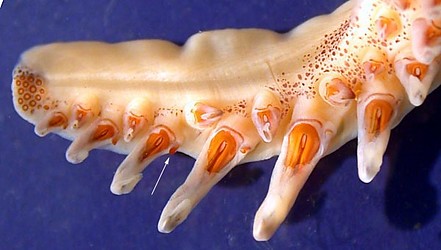
Figure. Oral views of tentacular club of O. compacta. Top - Original drawing by Keiko Hiratsuka Moore, National Marine Fisheries Service. Distal portion of club showing hook spikes (arrow), preserved. Photograph by R. Young.
Scanning electron micrographs of the hooks can be seen here.
- Head
- Beaks: Descriptions can be found here: Lower beak; upper beak.
- Beaks: Descriptions can be found here: Lower beak; upper beak.
- Mantle pigmentation
- Triangular-shaped region on the postero-ventral mantle lacks chromatophores.
Comments
Additional features of the description can be found here.Life History
Paralarvae of O. compacta are easily identified by the arrangement of their chromatophores. At 3-4 mm GL: A simple band (i.e., a single, straight line) of chromatophores is present along the free ventral margin of the mantle; a group of chromatophores is situated well posteriorly on the ventral mantle and two large chromatophores are located ventrally opposite the fins. At 6 mm GL: Two pairs of chromatophores are present on the ventral mantle adjacent to the fins. A small patch of chromatophores is present dorsally at the posterior convergence of the fins. At 9 mm GL: Two parallel rows of small chromatophores are located dorsally stradling the midline of the mantle. At 12-16 mm ML: Chromatophore numbers increase dramatically. At 18 mm ML: The subadult chromatophore pattern can be recognized.

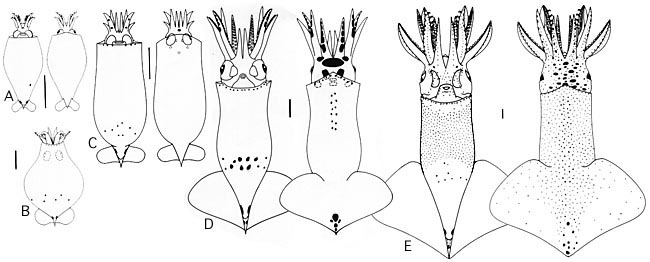
Figure. Ventral and dorsal views of paralarval and juvenile O. compacta. A - 2.3 mm GL. B - Ventral view of a common condition in this species: head retracted within the mantle cavity, 4.8 mm GL. C - 4.1 mm GL. D - 8.9 mm GL. E - 18.5 mm GL. The bar is 1 mm. Drawings from Young and Harman (1985).
Distribution
Until recently, known only from the Central Pacific, primarily 30°N–30°S; Bolstad (2010) reported additional material from the western north-central Atlantic, primarily 0–40°N. Probably worldwide in tropical to warm temperate oceans. Depth distribution unknown; majority of specimens collected at surface.References
Berry, S. S. 1913. Some new Hawaiian cephalopods. Proc. U. S. Nat. Mus. 45: 563-566.
Bolstad, K.S.R. 2010. Systematics of the Onychoteuthidae Gray, 1847 (Cephalopoda: Oegopsida). Zootaxa, 2696: 186 pp.
Kubodera, T., U. Piakowski, T. Okutani and M. R. Clarke. 1998 Taxonomy and zoogeography of the family Onychoteuthidae. Smiths. Contr. to Zoology, No. 585: 277-291.
Young, R. E. and R. Harman. 1985. Descriptions of the larvae of three species of the Onychoteuthis banksii complex from Hawaiian waters. The Veliger, 29: 313-321.
Title Illustrations

| Scientific Name | Onychoteuthis compacta |
|---|---|
| Location | Hawaiian waters |
| Creator | Keiko Hiratsuka Moore |
| Acknowledgements | National Marine Fisheries Service |
| View | Ventra, dorsal |
| Image Use |
 This media file is licensed under the Creative Commons Attribution-NonCommercial License - Version 3.0. This media file is licensed under the Creative Commons Attribution-NonCommercial License - Version 3.0.
|
| Copyright |
©

|
About This Page

National Museum of Natural History, Washington, D. C. , USA

University of Hawaii, Honolulu, HI, USA

Tokyo University of Fisheries, Tokyo, Japan
Page copyright © 2019 , , and
 Page: Tree of Life
Onychoteuthis compacta .
Authored by
Michael Vecchione, Richard E. Young, and Kotaro Tsuchiya.
The TEXT of this page is licensed under the
Creative Commons Attribution-NonCommercial License - Version 3.0. Note that images and other media
featured on this page are each governed by their own license, and they may or may not be available
for reuse. Click on an image or a media link to access the media data window, which provides the
relevant licensing information. For the general terms and conditions of ToL material reuse and
redistribution, please see the Tree of Life Copyright
Policies.
Page: Tree of Life
Onychoteuthis compacta .
Authored by
Michael Vecchione, Richard E. Young, and Kotaro Tsuchiya.
The TEXT of this page is licensed under the
Creative Commons Attribution-NonCommercial License - Version 3.0. Note that images and other media
featured on this page are each governed by their own license, and they may or may not be available
for reuse. Click on an image or a media link to access the media data window, which provides the
relevant licensing information. For the general terms and conditions of ToL material reuse and
redistribution, please see the Tree of Life Copyright
Policies.
- First online 23 June 2003
- Content changed 23 December 2010
Citing this page:
Vecchione, Michael, Richard E. Young, and Kotaro Tsuchiya. 2010. Onychoteuthis compacta . Version 23 December 2010 (under construction). http://tolweb.org/Onychoteuthis_compacta/19964/2010.12.23 in The Tree of Life Web Project, http://tolweb.org/




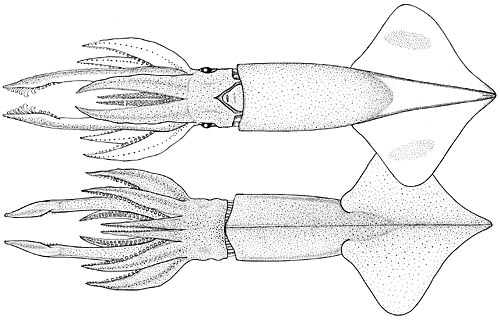
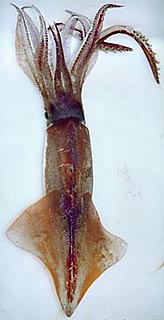

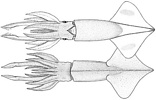



 Go to quick links
Go to quick search
Go to navigation for this section of the ToL site
Go to detailed links for the ToL site
Go to quick links
Go to quick search
Go to navigation for this section of the ToL site
Go to detailed links for the ToL site